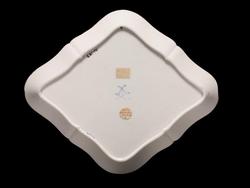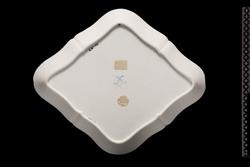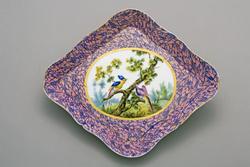Current Location: In storage
Titles
Plateau losange
Maker(s)
Factory:
Sèvres Porcelain Manufactory
(Uncertain)
Gilder:
Buteux, Pierre-Théodore
(Uncertain)
Entities
Categories
Description
Soft-paste porcelain tray, decorated with a pink marbled ground, and a reserve painted in enamels with two exotic birds perched in a tree, and gilding.
Soft-paste porcelain, moulded, and decorated overglaze with a rose marbré ground, painting in blue, shades of green, yellow, pink, purple, and brown enamels, and gilding. Diamond-shaped with slightly sloping sides and lobed edge. The glaze on the reverse is very speckly. There is a suspension hole in the footring at the top. The tray has a rose ground decorated with blue enamel marbling and sablé gilding.. The central oval reserve, is framed by a broad band of gilding tooled with panels of trellis separated by four strokes, and painted in polychrome with two exotic birds perching in the branches of a tree in a landscape. There are remnants of a band of gilding round the edge.
Notes
History note: Lent to the Fitzwilliam Museum by L.C.G. Clarke, in March 1948; bequeathed on his death on 13 December 1960
Legal notes
L.C.G. Clarke Bequest, 1960
Measurements and weight
Length: 29.5 cm
Width: 25.1 cm
Acquisition and important dates
Method of acquisition: Bequeathed
(1961-04-27)
by
Clarke, Louis Colville Gray
Dating
Louis XV
Circa
1760
CE
-
Circa
1763
CE
Note
A tray for dejeuners, described as a 'plateau losange' was introduced in 1756 and was made with plain or pierced sides without handles, or with plain or pierced sides with handles which could be scrolled or be a continuation of the zig-zag batons on the sides
Rose marbré grounds were used from about 1760 to about 1763 and could take various forms, some versions resembling marbling, others appearing more like pebbling, jagged stars, or shattered ice patterns. This tray bears an incised mark commonly found on Sèvres porcelain, but the decoration was almost certainly added later.
This tray has no date letter, and the four dot mark on the footring is similar to that of Théodore, now identified as Pierre-Théodore Buteux, but who did not begin working at the factory as a painter of blue edgings and gilder until 1765. Peters preferred to attribute the mark of four dots and one dot to an unidentified painter of birds c. 1758
School or Style
Rococo
Components of the work
Decoration
composed of
enamels
( blue, shades of green, yellow, pink, purple, and brown)
ground colour
( pink)
gold
Side
Height 3 cm
Materials used in production
Lead-glaze
Soft-paste porcelain
Techniques used in production
Moulding
: Soft-paste porcelain, moulded, and decorated with a rose marbré ground with sablé gilding, painted in blue, shades of green, yellow, pink, purple, and brown enamels, and gilding.
Lead-glazing
Inscription or legends present
- Text: 19 or 61
- Location: On base by footring to right of suspension hole at top
- Method of creation: Incised
- Type: Incised mark
Inscription present: interlaced Ls enclosing a dot
- Location: On base
- Method of creation: Painted in blue enamel
- Type: Factory mark
Inscription present: four dots
- Location: On footring
- Method of creation: Painted in blue enamel
- Type: Mark
Inscription present: circular white paper label
- Text: Lent by/Louis C G Clarke/March 1948/1 (last in black)
- Location: On base
- Method of creation: Hand-written in red ink
- Type: Label
- Text: Painter/Aloncle/Gild/Theodore
- Location: On base
- Method of creation: Hand-written in blue ink
- Type: Label
References and bibliographic entries
Identification numbers
Accession number: C.27-1961
Primary reference Number: 73961
Stable URI
Audit data
Created: Saturday 6 August 2011
Updated: Tuesday 29 November 2022
Last processed: Thursday 14 August 2025
Associated departments & institutions
Owner or interested party:
The Fitzwilliam Museum
Associated department:
Applied Arts

 IIIF Manifest
IIIF Manifest






